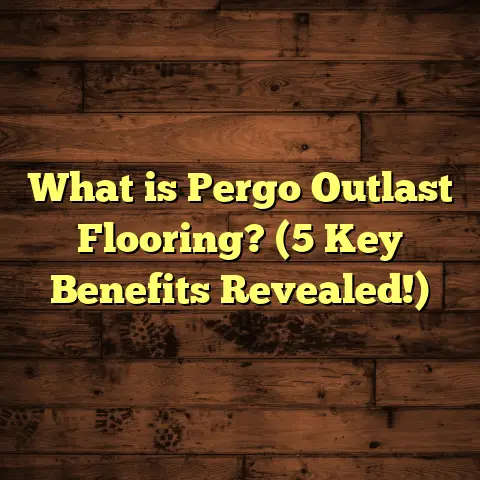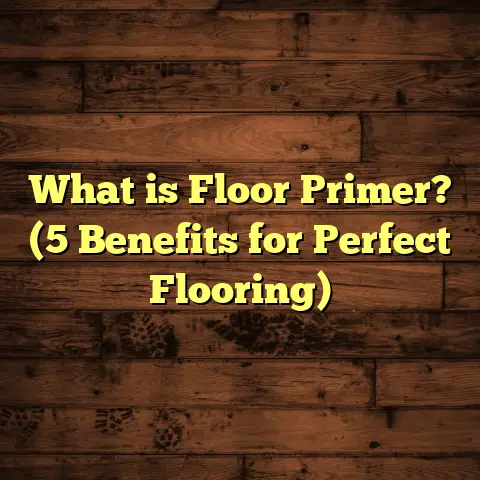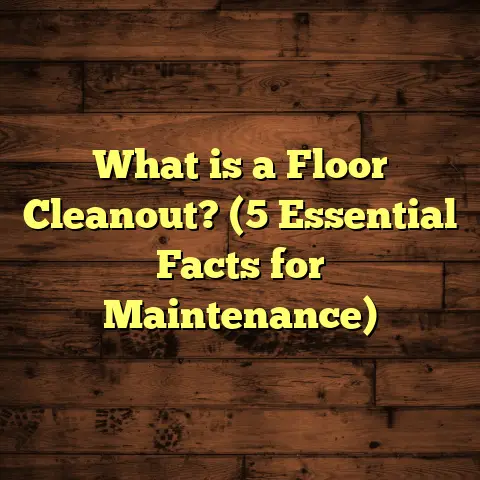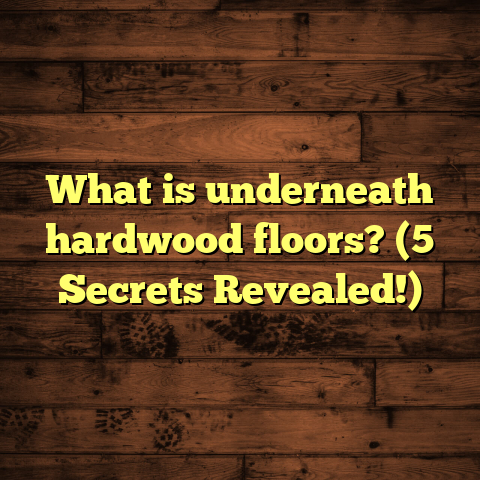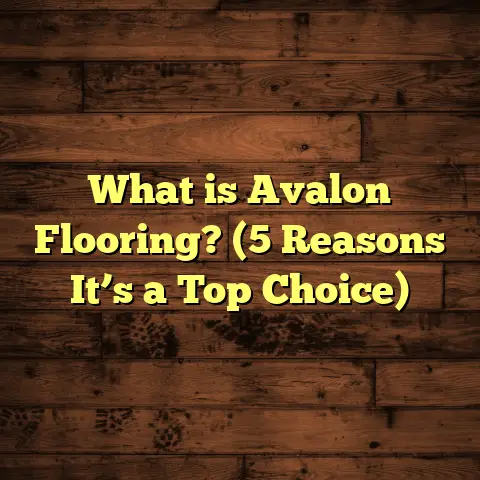What is Cushioned Vinyl Flooring? (5 Benefits You Need to Know)
I remember the first time I really paid attention to cushioned vinyl flooring. I was helping a family renovate their kitchen, and they were torn between keeping their old hardwood or trying something new. Then, the flooring rep showed us cushioned vinyl, and I was honestly surprised by how much it offered. The softness, the design options, and the practicality all came together in a way I hadn’t fully appreciated before. What really surprised me was how vinyl flooring has evolved from the thin, hard sheets of my childhood to this thick, cushioned material that can be both beautiful and comfortable. If you’ve ever thought vinyl was “cheap” or “plastic-looking,” this might change your mind.
What Is Cushioned Vinyl Flooring?
Put simply, cushioned vinyl flooring is a type of vinyl flooring that includes a soft backing layer attached underneath the main vinyl surface. This backing is usually made from foam or felt and makes walking or standing on the floor more comfortable compared to traditional vinyl.
While traditional vinyl flooring consists primarily of a wear layer and a printed design layer on top of a vinyl core, cushioned vinyl adds that extra layer of comfort below. This gives it a bit of “give” when you walk on it, reducing fatigue and joint stress.
The layers typically look like this:
- Wear Layer: A clear, tough surface designed to protect against scratches, stains, and wear.
- Design Layer: A printed pattern or image that gives the floor its appearance—wood grain, stone, tile, or abstract designs.
- Vinyl Core Layer: Offers waterproofing and structural integrity.
- Cushion Backing: The foam or felt layer that adds softness underfoot, soundproofing properties, and warmth.
In terms of thickness, cushioned vinyl products range from about 3mm to 6mm total thickness, with the cushion itself generally around 2mm to 4mm thick.
Why Is This Cushioning Important?
You might think: “Why does a little cushion matter so much?” If you spend time standing in your kitchen cooking or washing dishes, or if you stand a lot at work or in a retail environment, having a cushioned surface makes a huge difference in comfort. It reduces the pressure on your feet and joints.
Plus, that cushioning also helps absorb sound. This is especially handy in apartments or multi-level homes where noise travels easily. The thicker the cushion, generally, the better the sound dampening effect.
My Personal Journey With Cushioned Vinyl Flooring
I’ve worked in flooring for over 15 years and have seen trends come and go. But cushioned vinyl has steadily grown in popularity because it hits a sweet spot for many homeowners—comfort meets durability meets style without a huge price tag.
One memorable project was with a young couple who had just moved into their first home with two toddlers. They wanted something safe for their kids’ playroom but also stylish enough for their open concept living area. Hardwood floors were out of the budget and carpet was too hard to clean with sticky little fingers always around.
We installed cushioned vinyl planks that mimicked natural oak wood. The kids loved the soft feel when sitting and playing on the floor. The parents loved how easy it was to clean up spills and mud tracked in from outside. After six months, they told me they couldn’t believe how little wear showed and how much quieter the house felt.
That’s when I realized cushioned vinyl isn’t just an alternative—it can be the solution for busy families.
1. Comfort: More Than Just a Feeling
Let’s talk about comfort first because this is where cushioned vinyl really shines.
Have you ever stood on hardwood or tile for long periods? Your feet start to ache, your knees feel stiff. I’ve been there during long renovations where I’m on my feet all day. Cushioned vinyl floors help relieve this pressure thanks to their soft backing layer.
The cushion acts like a shock absorber. It reduces the impact on your feet and joints by distributing weight more evenly. This can lead to less fatigue and pain over time.
Real Data on Comfort
According to research by the American Podiatric Medical Association (APMA), softer flooring surfaces reduce pressure on feet by approximately 30% compared to hard surfaces like tile or concrete. This reduction can make standing for prolonged periods much easier on your body.
In commercial settings like retail or healthcare environments where workers are on their feet all day, cushioned vinyl is often preferred for this reason alone.
2. Durability That Lasts
One concern I often hear is: “Is vinyl durable enough?” The answer depends on quality and installation but generally yes—especially with cushioned vinyl.
The wear layer on these floors protects against scratches, scuffs, stains, and fading from sunlight. The vinyl core below is waterproof and resistant to dents or warping from moisture.
During a recent project renovating a pet-friendly home with active dogs and kids, cushioned vinyl held up remarkably well despite lots of paw traffic and occasional spills. The soft backing didn’t compress permanently even after years of use.
How Durable Is Cushioned Vinyl?
- Lifespan: With proper maintenance, cushioned vinyl floors typically last 10-20 years.
- Scratch Resistance: High-quality wear layers resist scratches from pets’ claws or furniture.
- Water Resistance: Vinyl is naturally waterproof; cushioned vinyl won’t warp or rot like wood.
According to industry reports, vinyl flooring sales have grown by over 40% in the past decade as consumers seek durable yet affordable options.
3. Sound Absorption: Peace and Quiet Underfoot
If you live in an apartment or a multi-level home, noise can be a real problem. Footsteps echoing through the floor can disrupt conversations or make it hard for kids to nap.
Cushioned vinyl’s foam layer acts as an effective sound barrier. It absorbs impact noise rather than bouncing it around like harder surfaces do.
I installed cushioned vinyl in an office building where loud noise was a constant complaint. After installation, employees reported significantly less distraction from foot traffic sounds overhead.
Decibel Reduction
A study published by flooring experts showed cushioned vinyl can reduce impact noise by around 15 decibels compared to traditional hard vinyl sheets—a noticeable difference in everyday life.
4. Stylish Yet Affordable Flooring Options
One thing that caught me off guard when I first saw cushioned vinyl was the variety of designs available. Today’s printing technology can mimic almost any natural material—from rustic wood planks to cool stone tiles—at a fraction of the price.
This means you don’t have to compromise style for budget. You can get floors that look high-end for much less money.
Cost Breakdown
- Cushioned Vinyl: $2–$5 per square foot (installed)
- Hardwood Flooring: $8–$15 per square foot (installed)
- Natural Stone Tile: $10–$20 per square foot (installed)
For many homeowners I work with, this price difference is huge—especially when upgrading large areas like kitchens or basements.
5. Easy Installation Saves Time and Money
If you enjoy DIY projects or want minimal disruption during renovations, cushioned vinyl is a great choice.
Many products come with click-lock systems or peel-and-stick backs that make installation straightforward—no messy glue or special tools required.
I once helped a friend install cushioned vinyl over an old tile floor in her laundry room over a weekend. She was amazed at how quickly it went down compared to previous flooring projects she had done.
Installation Tips:
- Make sure subfloor is clean and level
- Acclimate flooring to room temperature before installation
- Use recommended underlayment if needed
- Follow manufacturer instructions carefully
Professional installation is recommended for large areas or commercial spaces but overall it’s easier than hardwood or ceramic tile work.
How Does Cushioned Vinyl Compare With Other Flooring Types?
Here’s where things get interesting because many people ask me how cushioned vinyl stacks up against popular alternatives:
| Flooring Type | Comfort | Durability | Water Resistance | Cost Range | Maintenance |
|---|---|---|---|---|---|
| Cushioned Vinyl | High | High | Excellent | $2 – $5/sq ft | Easy (sweep/mop) |
| Hardwood | Medium | Medium/High | Poor | $8 – $15/sq ft | Requires refinishing |
| Laminate | Low/Medium | Medium | Poor | $3 – $7/sq ft | Moderate |
| Carpet | High | Low | Poor | $2 – $6/sq ft | Requires vacuuming |
| Ceramic Tile | Low | High | Excellent | $5 – $15/sq ft | Grout cleaning needed |
If you want comfort plus water resistance and easy maintenance at an affordable price point, cushioned vinyl shines above most options.
Case Studies From My Work
Case Study 1: Family Kitchen Renovation
A family of five wanted new flooring in their kitchen but didn’t want cold tiles or high-maintenance hardwood. We installed cushioned vinyl planks with walnut wood grain textures.
Results:
- Reduced foot fatigue during meal prep
- Easy cleanup from spills and crumbs
- No visible wear after two years despite heavy use
Case Study 2: Office Space Upgrade
An accounting firm needed quiet floors for concentration but wanted something modern-looking without carpet allergens.
Results:
- Noise reduction improved focus
- Stylish stone-look tiles enhanced aesthetics
- Staff reported more comfortable workdays
Case Study 3: Basement Living Area
A homeowner converted their damp basement into a cozy family room with cushioned vinyl flooring instead of carpet.
Results:
- Waterproof surface prevented mold issues
- Warmth underfoot increased comfort
- Durable enough for pets and kids
Choosing the Right Product: What I Recommend
With so many brands and products out there, it’s easy to get lost. Here’s what I look for when selecting cushioned vinyl:
- Wear Layer Thickness: At least 12 mil (0.3 mm) for homes; thicker if heavy use.
- Cushion Quality: Closed-cell foam cushions last longer than open-cell.
- Warranty: Minimum 10-year warranty is ideal.
- Waterproof Guarantee: Check manufacturer claims carefully.
- Style Options: Pick something timeless yet practical.
Brands I trust include Armstrong, Shaw Floors, Mannington—all offer solid warranties and quality products.
Maintenance Advice I Share With Clients
To keep your cushioned vinyl floor looking great:
- Sweep regularly with a soft broom
- Mop with mild soap solutions (avoid harsh chemicals)
- Clean spills immediately
- Use furniture pads under heavy items
- Avoid sharp objects dragging across surface
A little care goes a long way—these floors don’t require waxing or refinishing like hardwood does.
Frequently Asked Questions I Get About Cushioned Vinyl
Q: Can I install cushioned vinyl in bathrooms?
A: Absolutely! It’s waterproof so perfect for wet areas but ensure seams are sealed well.
Q: Is it safe for pets?
A: Yes! It resists scratches better than many surfaces and cleans easily after accidents.
Q: How often should I replace it?
A: With good care, expect 10–20 years depending on traffic levels.
Q: Does it fade in sunlight?
A: Quality products have UV protection layers but try to limit direct sun exposure.
Final Thoughts From Me
Cushioned vinyl flooring surprised me when I first encountered it—and now it’s one of my go-to recommendations for many projects. It offers a unique combination of comfort, style, durability, and affordability that’s tough to beat.
If you’re weighing your options for kitchen floors, playrooms, basements, or offices—why not give cushioned vinyl serious consideration? It might just be exactly what you need to make your space both beautiful and comfortable without stress or overspending.
Have you tried cushioned vinyl before? Or do you have questions about whether it’s right for your home? Feel free to ask—I’m happy to share my insights!
